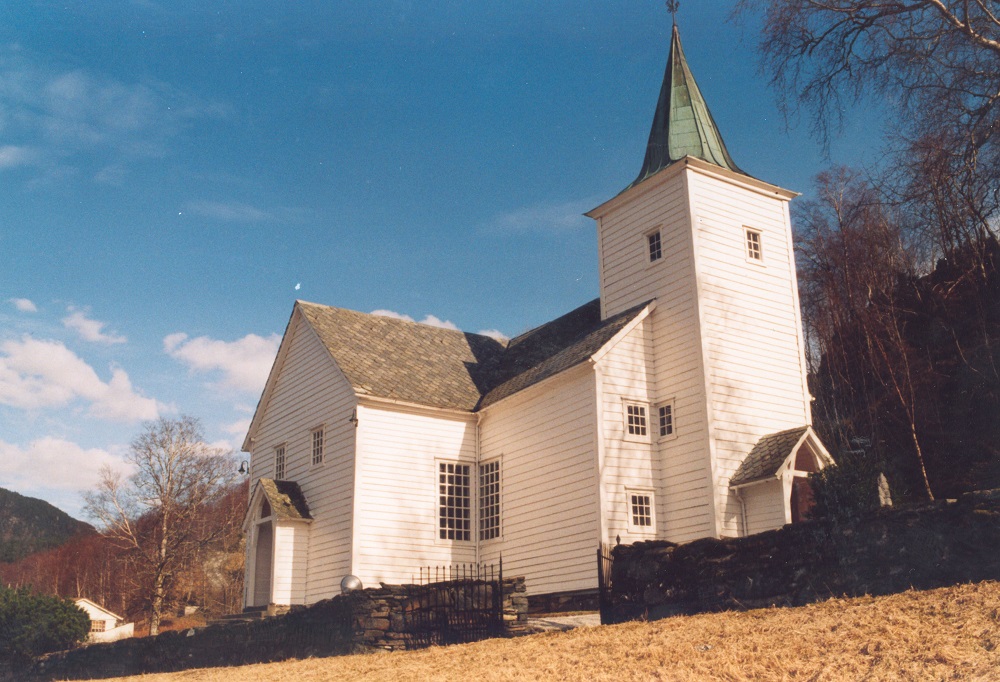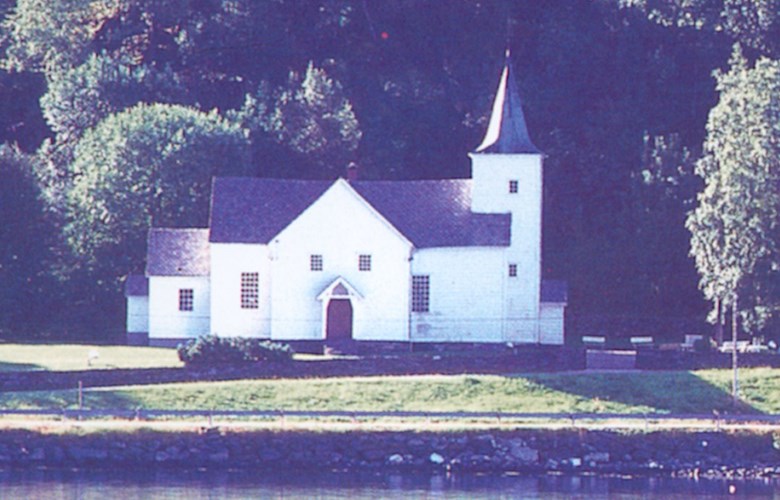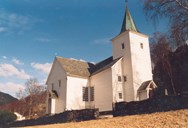Cruciform church
Eikefjord church is one of the oldest churches in the region of Sunnfjord, representing the first generation of wooden churches from the 19th century. After a later extension it is now one of the three cruciform churches in the county, the two others being the old church in Olden and Tønjum church.
The church in Eikefjord belongs to the same generation of churches in Sunnfjord as Ålhus (1795) and Hestad (1805), and its completion marked the first new church site in the county since the 1600s. The church is situated under a steep crag, a short distance to the south of the present centre of the village. At Sørbøen where the church is situated, there was formerly a post station, a shop, as well as post and shipping offices from 1877.
The extension of 1874
About 1810, the villagers combined their efforts to build a church, with Søren Agledal as a driving force. The building materials were transported down to the sea where the timber was cut into boards with a hand saw or cut into beams and posts with an adze (axe with an arched blade). The master builder was Nils Olsen Kjørslevik who had learne his trade in Bergen.
At first it was a small longchurch with a seating capacity of 150-200. The church was privately owned, but in connection with the comprehensive restoration work in 1974 when it was turned into a cruciform church, it was sold to the "sokn" for 1000 "speciedaler". The "sokn" council considered the price too high, but still accepted.
The reason for the reconstruction work was - as was the case many places - the population growth in the "sokn". For some time, there were even plans of building a new church, but the outcome was that Christoffer Svanøe proposed an outline for a reconstruction to a cruciform church, and this was accepted by the "sokn" council. In the middle of either side wall of the nave a transept was built, and thus the church became cruciform. On each "cross branch" a small entrance was also built, so that from each extremity of the cross-shaped building there were five corners, one behind the other, until the next extremity of the building. The old porch in the west end with the turret above was left unchanged.

Additonal renovation work
The church is both spacious, light, and has a pleasant ambience. The cruciform construction means that the congregation does not sit far from the vicar or the chancel. There are galleries in three of the cross branches (apart from the chancel), and in each interior corner there are two big windows. The timber walls are painted brown, and the ceiling is painted in a lighter colour. The church builder John J. Alver carried out the work in 1874 for 1100 "speciedaler", including a spire, and, if necessary, a new altarpiece and pulpit. The same working team built the Stavang church the year before.
Throughout the years, some major and minor changes have been made. A vestry with two rooms was built in the eastern end in 1936, with its own entrance behind the altarpiece in the chancel. The church was heated by wood stoves up until 1953, and the stove still remains in the church. In the 1970s, water and sanitary facilities were installed, and later on floodlight. In 1999, the floor was polished and the interior repainted. New carpets were laid in the central aisles and the chancel. The pews were refurbished with new cushions.
At first the church was a chapel site under the "sokn" on the island of Svanøy, but has been a "sokn" of its own since 1890. In 2000, there were services every other Sunday.
Art and interior
The altarpiece from 1874 is a copy of Bertel Thorvaldsen's (1770-1844) Crist sculpture from 1829, of the same kind as the one in Florø church. There is a small difference, however, in that the Eikefjord sculpture is carved in wood, whereas the Florø sculpture is made of zinc. In Eikefjord church there is a carved and painted wall behind the sculpture, and on the base of this wall the following text is inscribed: "He is our Peace".
On the altar theer are two brass candlesticks from about 1900. The Holy Communion objects consist of a chalice and dish in silver from 1812, a gift from the vicar sokneprest Claus Finde who served in the Kinn parish between 1784 and 1816. The pulpit probably dates from 1874. The font is from 1812, the baptismal bowl and the holy water ewer date from 1964. The brass chandelier probably dates from the 17th century.
The seven-register organ is from 1961. It was formerly used in Eid church in Nordfjord, and it was paid for by a donation from Ola O. Agledal in addition to raised means.
There are two church bells, one from 1848, made by Becher in Bergen. It carries the inscription: "Made to the chapel of Egefjorden (sic) Soli Deo Gloria". The other bell dates from 1963, and is made by "Olsen & Søn", Nauen, with the inscription "Eikefjord church A.D. 1963 - Gift from Ola O. Agledal. In majorem dei gloriam" (To the greater glory of God).
The islet of corpses
When the church was being built, the "sokn" church was on the island of Svanøy, and there are many stories about the strenuous voyages to get to church. A very special and tragic occasion may have played a part leading to the building of Eikefjord church. Five men from Lykkjebøen (on the roads towards Hyen) had been to church at Svanøy and had reached Eikefjorden on their return journey Sunday evening. During the night, the weather conditions worsened with storm and rain, and when they in the morning wanted to cross the frozen lake of Endestadvatnet, disaster struck. The five of them broke through the ice and drowned with their wives as helpless witnesses from a nearby hill. The men were eventually found and placed on a small islet in the lake, and to this day this islet is called "Likholmen" (literally the islet of corpses).



